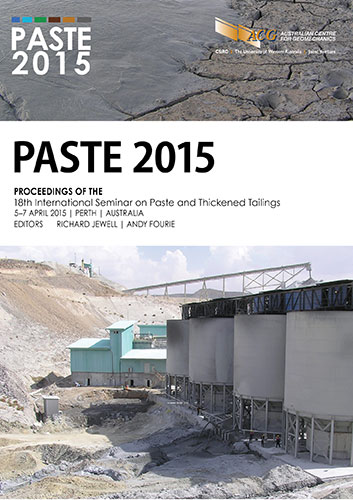A launder design method for thickened tailings

|
Authors: Fitton, TG |
DOI https://doi.org/10.36487/ACG_rep/1504_19_Fitton
Cite As:
Fitton, TG 2015, 'A launder design method for thickened tailings', in R Jewell & AB Fourie (eds), Paste 2015: Proceedings of the 18th International Seminar on Paste and Thickened Tailings, Australian Centre for Geomechanics, Perth, pp. 267-276, https://doi.org/10.36487/ACG_rep/1504_19_Fitton
Abstract:
In mountainous terrain, thickened tailings slurries are often transported by gravity flow in open channel launders (also called channels or flumes). These launders are typically constructed of concrete, and can run for many kilometres, as they transport the tailings slurry from the mine to a tailings storage facility at a lower elevation. Some of the large copper mines of Chile and Iran feature such launders, with some notable examples being Andina, Chile (57 km, carrying some 70,000 dry tonnes per day), Chuquicamata, Chile (15 km with 200,000 dry tonnes per day), El Teniente, Chile (86 km, 130,000 tpd) and Sarcheshmeh, Iran (16 km, 60,000 tpd). The main advantage of such launders is the ability to avoid pumping of the slurry. In mines such as these, the cost of pumping such vast amounts of tailings would be considerable. Launder cross-sections can come in many shapes, with common geometries being rectangular, trapezoidal and U-shaped. Circular pipes flowing partially full also function well as launders, and can offer certain advantages over the more common open-topped concrete sections. This paper presents a simple method for designing launders for the gravity transport of tailings slurries. The method applies to both Newtonian and non-Newtonian slurries, and works on the basis that the slurry flow maintains sufficient velocity to avoid deposition of solid particles in the launder. With inputs of flow rate, slurry concentration, rheology, particle specific gravity and particle size distribution, the design method calculates cross-sectional dimensions for a launder of rectangular, trapezoidal or circular cross-section, and then calculates a minimum slope required for the total transport of the slurry.
References:
Abulnaga, BE 2002, Slurry systems handbook, McGraw-Hill Professional Publishing, New York.
Fitton, TG 2007, ‘Tailings beach slope prediction’, PhD thesis, RMIT University.
Fitton, TG 2008, ‘Non-Newtonian open channel flow – a simple method of estimation of laminar/turbulent transition and flow resistance’, in AB Fourie, RJ Jewell, P Slatter & A Paterson (eds), Proceedings of the Eleventh International Seminar on Paste and Thickened Tailings, Australian Centre for Geomechanics, Perth, pp. 245-252.
Haldenwang, R 2003, ‘Flow of non-Newtonian fluids in open channels’, D.Tech. thesis, Cape Technikon.
Lacey, G 1946, ‘A general theory of flow in alluvium’, Journal of the Institution of Civil Engineering, vol. 27, pp. 16-47, and vol. 28, pp. 425-451.
Oroskar, AR & Turian, RM 1980, ‘The critical velocity in pipeline flow of slurries’, AIChE Journal, vol. 26, no. 4, pp. 550-558.
Pirouz, B, Seddon, KD, Pavissich, C, Williams, MPA & Echevarria, J 2013, ‘Flow through tilt flume testing for beach slope evaluation at Chuquicamata Mine Codelco, Chile’, in RJ Jewell, AB Fourie, J Caldwell & J Pimenta (eds), Proceedings of the 16th International Seminar on Paste and Thickened Tailings, Australian Centre for Geomechanics, Perth, pp. 457-472.
Slatter, PT 2013, ‘Analysis and flow behaviour prediction of paste material in sheet flow’, in RJ Jewell, AB Fourie, J Caldwell &
J Pimenta (eds), Proceedings of the 16th International Seminar on Paste and Thickened Tailings, Australian Centre for Geomechanics, Perth, pp. 473-480.
Thomas, AD 1979, ‘Predicting the deposit velocity for horizontal turbulent pipe flow of slurries’, International Journal of Multiphase Flow, vol. 5, pp. 113-129.
US Army Corps of Engineers 2015, ‘Hydrologic Engineering Centers River Analysis System’, US Army Corps of Engineers, Davis,
Wasp, EJ, Kenny, JP & Gandhi, RL 1977, Solid-liquid flow slurry pipeline transportation, Trans Tech Publications, Clausthal-Zellerfeld.
© Copyright 2025, Australian Centre for Geomechanics (ACG), The University of Western Australia. All rights reserved.
View copyright/legal information
Please direct any queries or error reports to repository-acg@uwa.edu.au
View copyright/legal information
Please direct any queries or error reports to repository-acg@uwa.edu.au